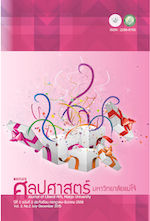จาก “ซอนํ้าท่วม” ถึง “เพลงผาวิ่งชู้” สู่ “ผ้าซิ่นนํ้าท่วม”: การต่อสู้ด้วยภาษา และอุดมการณ์ล้านนานิยม
Main Article Content
Abstract
The Underlying Concepts through the Lanna Folk Songs Named “So Nam Tuam” and “Pha Wing Chu”, and the Lanna Salongs Called “Phasin Nam Tuam”: the Counter Discourse and Lannaism Ideology
The purposes of this article are to discover and analyze the underlying ideologies of the Lanna folk songs named “So Nam Tuam” and “Pha Wing Chu”, and to understand the concept of signification to “Phasin Nam Tuam”—a certain type of the women’s traditional long woven tube-skirts. According to the ideological concept introduced by Louis Althusser, it was found that those three mentioned contexts are all the process for building up social memories through Lannaism ideological storytelling. Building the memories was told based on the sufferings of people affected by dam construction. There were 3 types of suffering: suffering of displacement, suffering of government’s land allocation, and suffering of land and property loss. Under the Lannaism ideology, the textual contents were kind of retorts and responses against the government. The conflict counterparts were created into 2 ways: the conflict between the affected people and the dam, and the conflict between the affected people and their government. However, there were 2 points were changed in order to make the government’s resistance appear not too obviously. First, the government’s po licy of building the dam was praised, and the matters unrelated to dam building were discussed.

